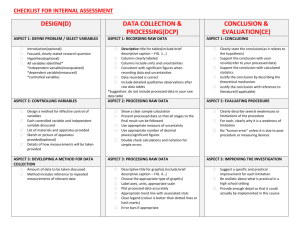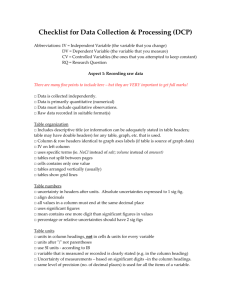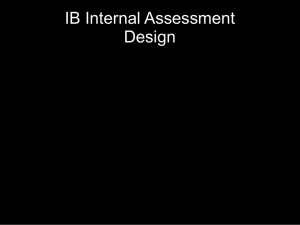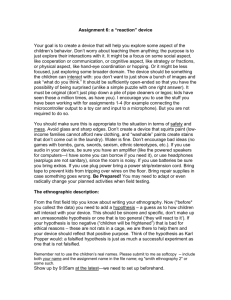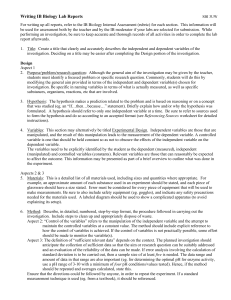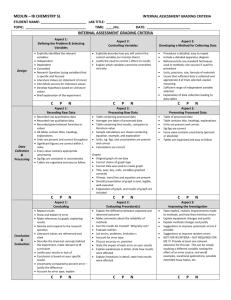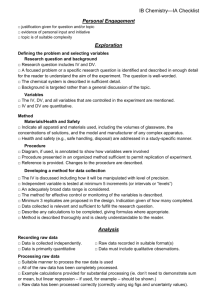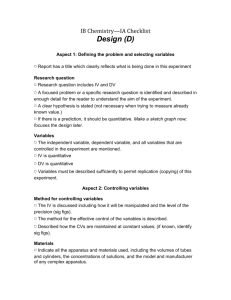IB Chemistry Lab Report Format: Internal Assessment Guide
advertisement
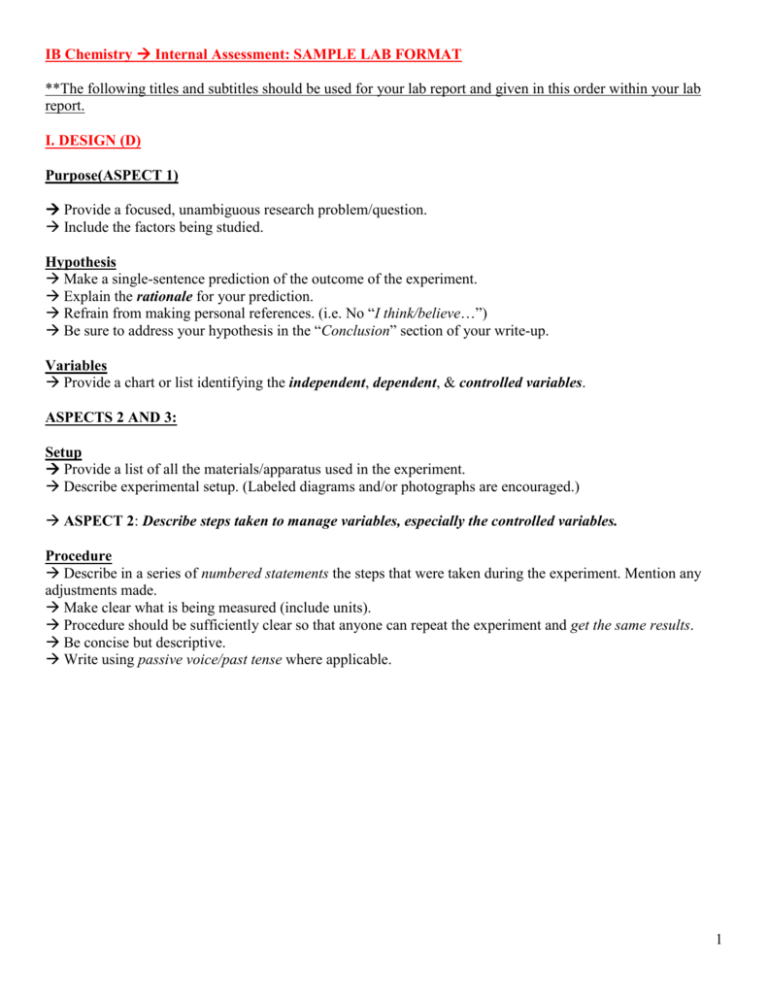
IB Chemistry Internal Assessment: SAMPLE LAB FORMAT **The following titles and subtitles should be used for your lab report and given in this order within your lab report. I. DESIGN (D) Purpose(ASPECT 1) Provide a focused, unambiguous research problem/question. Include the factors being studied. Hypothesis Make a single-sentence prediction of the outcome of the experiment. Explain the rationale for your prediction. Refrain from making personal references. (i.e. No “I think/believe…”) Be sure to address your hypothesis in the “Conclusion” section of your write-up. Variables Provide a chart or list identifying the independent, dependent, & controlled variables. ASPECTS 2 AND 3: Setup Provide a list of all the materials/apparatus used in the experiment. Describe experimental setup. (Labeled diagrams and/or photographs are encouraged.) ASPECT 2: Describe steps taken to manage variables, especially the controlled variables. Procedure Describe in a series of numbered statements the steps that were taken during the experiment. Mention any adjustments made. Make clear what is being measured (include units). Procedure should be sufficiently clear so that anyone can repeat the experiment and get the same results. Be concise but descriptive. Write using passive voice/past tense where applicable. 1 II. DATA COLLECTION AND PROCESSING (DCP) Raw Data (ASPECT 1) record all raw data and observations (Be sure not to include processed data here.) include both quantitative and qualitative data Data should be properly presented clearly in a table/chart. All raw data tables must have a descriptive title. Make sure that all columns are properly headed and units are given. Uncertainties are mandatory and can be given within column headings for equipment precision and as footnotes beneath data tables for other types of uncertainties. Data Processing (ASPECT 2) Process data in order to produce results that can be interpreted. (May involve the calculation of ranges, means, or modes, for example.) Demonstrate errors and uncertainties in your data and propagate errors appropriately. Include relevant formulas. Units need to be present in final answers only. Sample calculation: Neatly present and explain one example only of any type of manipulation that was done to the raw data to help make it more useful for interpretation. Data Presentation (ASPECT 3) This is typically one or more data tables (of your processed data) and one or more graphs of this processed data. Once again, the design & clarity of data table(s) and graphs is important. Give careful consideration to the choice of graph style(s) that you choose to do. Think about doing a scatter plot or perhaps a line graph showing error bars or any number of other creative graphing styles rather than just a simple line graph. Remember to include errors and uncertainties in this data also. Make sure that you follow good standard rules for doing graphs (descriptive title, axes labeled, appropriate intervals, units, etc.) All figures and graphs should have captions (include errors/uncertainties). 2 III. CONCLUSION AND EVALUATION (CE) Conclusion (ASPECT 1) This is a paragraph section in which you get a chance to discuss the results of your experiment. Start with a short restatement of the purpose of the experiment. Next, address whether your data seems to support or refute your hypothesis. This should be discussed and not just stated. Answer original question/purpose in terms of your hypothesis. Justify your conclusions with interpretation of the processed data. (Include specific examples of findings refer to your graphs, trends, averages etc.). When appropriate, compare results with previous research. Evaluating Procedure (ASPECT 2) Identify an evaluate limitations, weaknesses, or errors of methodology. Include specific errors and how those errors may have affected your data and findings - may include but not limited to equipment uncertainties. Improving Investigation (ASPECT 3) Recommend specific modifications for future experiments. Modifications should address weaknesses and limitations discussed in procedure evaluation. 3
